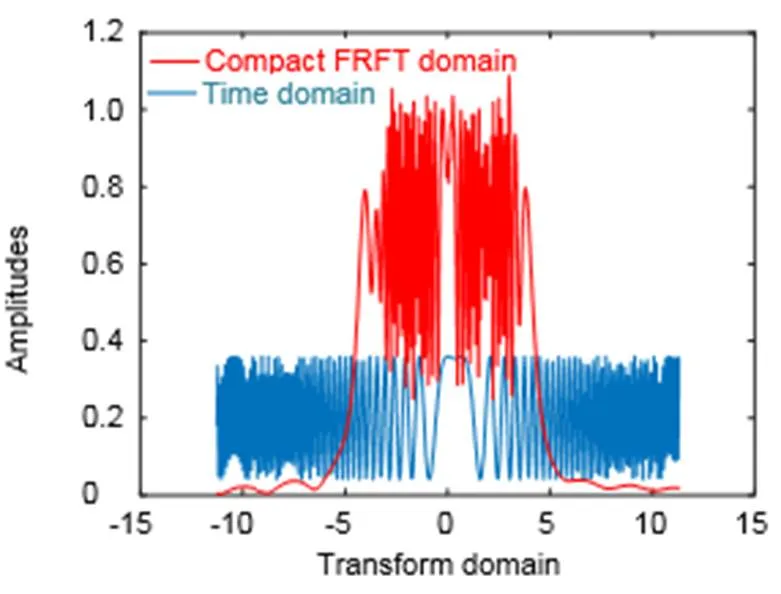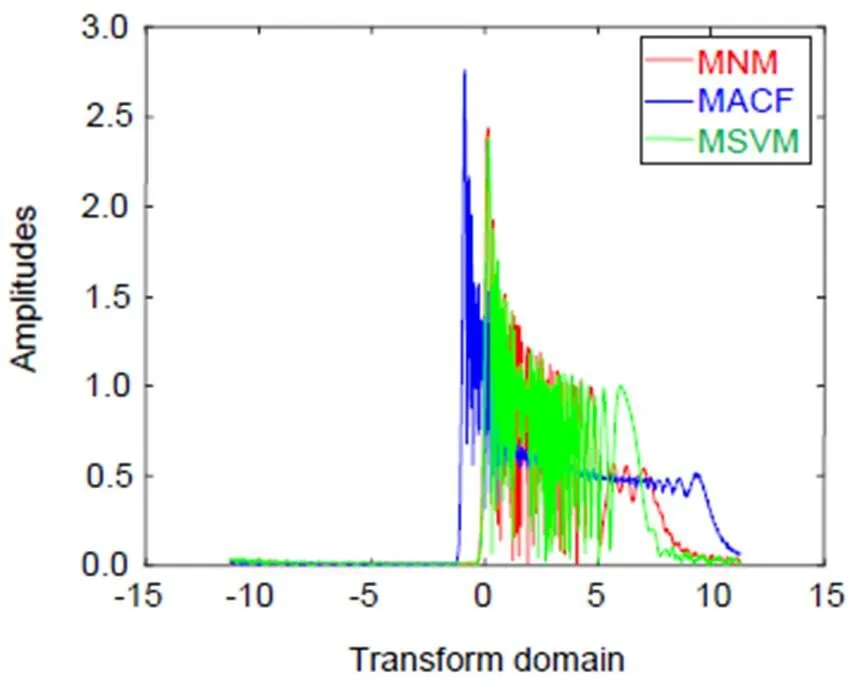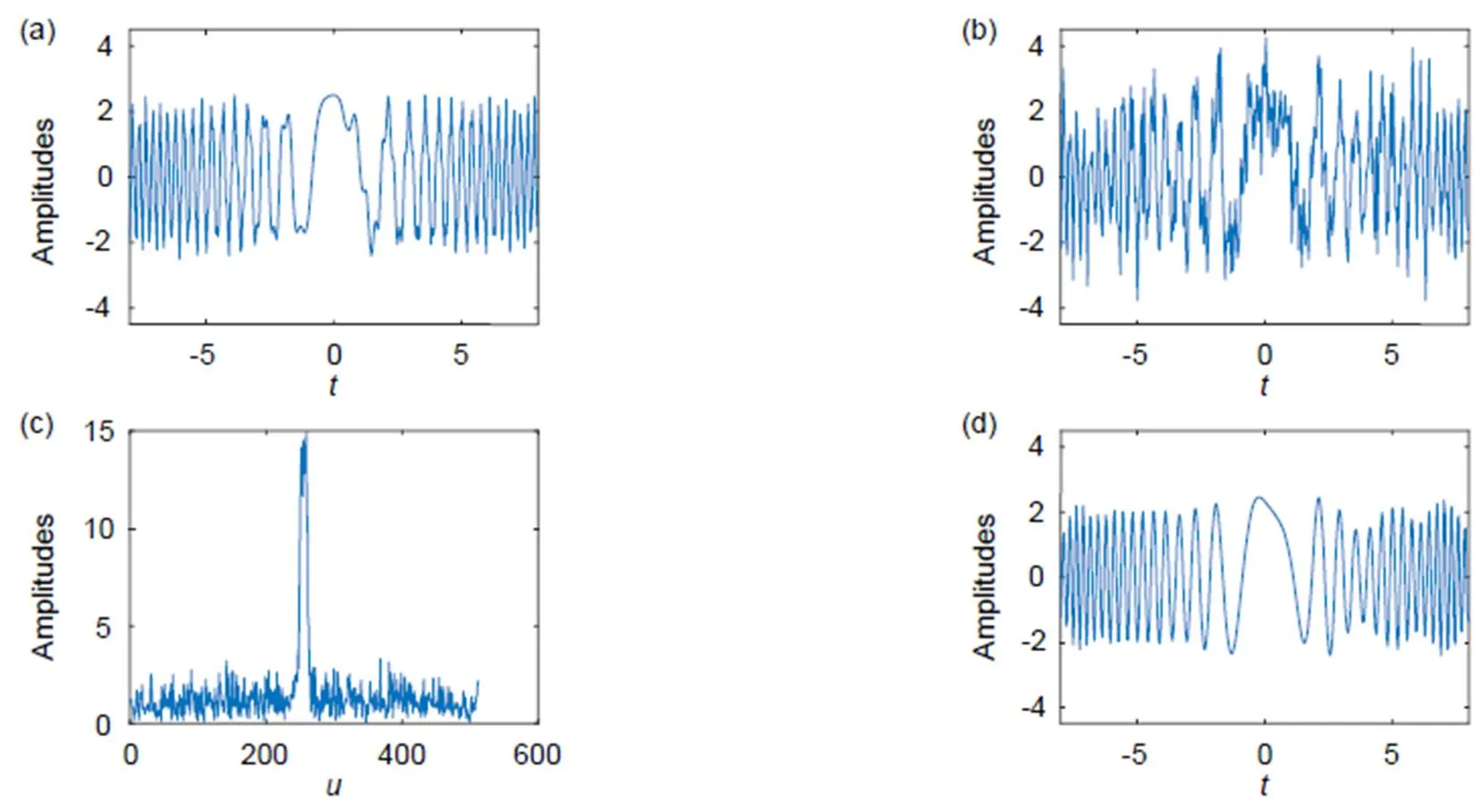分数傅里叶变换域的调频信号稀疏性研究
2020-12-11杨立东
王 硕,郭 勇,杨立东
分数傅里叶变换域的调频信号稀疏性研究
王 硕1,郭 勇2*,杨立东1
1内蒙古科技大学信息工程学院,内蒙古 包头 014010;2内蒙古科技大学理学院,内蒙古 包头 014010
调频信号广泛应用于声纳、雷达、激光和新兴光学交叉研究领域,其紧致性(稀疏性)是调频信号采样、去噪、压缩等研究中面临的共性基础问题。本文致力于研究调频信号在分数傅里叶变换域的稀疏性,提出了一种最大奇异值法来估计调频信号的紧致分数傅里叶变换域。该方法利用调频信号幅度谱的最大奇异值来度量其紧致域,并应用鲸鱼优化算法来搜寻紧致域,有效改善了现有方法的不足。与MNM和MACF方法相比,本文方法给出了调频信号在分数傅里叶变换域更加稀疏的表征,具有更少的重要振幅数。最后,给出了该方法在调频信号滤波中的初步应用。
调频信号;稀疏性;分数傅里叶变换;奇异值分解

1 引 言
调频信号是一种典型的非平稳信号,广泛应用于声纳、雷达、激光等传统领域[1-3]。近年来,它开始应用于新兴的光学交叉领域,如微波与光学交叉的微波光子学[4-6]、传统光学测量与信号处理交叉的新兴光学测量领域[7-10]。调频信号的稀疏表示是调频信号采样、滤波、压缩等研究中面临的共性基础问题,开展其稀疏性研究对于声纳、雷达和激光等传统领域以及新兴的光学交叉领域具有重要的理论和实际意义。

因此,针对现有研究中存在的问题,本文提出一种最大奇异值法(maximum singular value method, MSVM)来估计调频信号在分数傅里叶变换域的稀疏性。MSVM采用分数傅里叶变换域幅度谱的最大奇异值来度量紧致域,具有较好的稀疏性和噪声鲁棒性。由于奇异值分解能够将高维的数据空间映射到低维的数据空间,有效降低处理数据的维度,而且奇异值分解能用于任意矩阵,适用性更广。另外,该方法采用鲸鱼优化算法(whale optimization algorithm, WOA)[31]来搜寻紧致域。由于WOA具有灵活性强、无梯度限制,且可以有效避免陷入局部最优点等优势,因此有效改善了从粗到细的网格搜索和遍历搜索的不足。最后,本文给出了MSVM在线性调频信号滤波中的初步应用,显示了该方法潜在的应用价值。
本文第2节简单介绍了分数傅里叶变换的定义和基本性质;第3节探索研究了调频信号在分数傅里叶变换域的稀疏性;第4节基于线性调频信号和二次调频信号进行了仿真分析;第5节介绍了该方法在线性调频信号滤波中的初步应用;第6节对本文的工作进行了简要总结。
2 分数傅里叶变换



分数傅里叶变换不仅具备傅里叶变换的性质,同时还具备一些其他性质[11]:


其中WVD的定义为[11]

因此,从时频分析的角度来看,分数傅里叶变换可以看作时频平面上的旋转变换,它可以提供时域和频域之间关于旋转角度的连续映射。因此,如何寻找最佳的旋转角度,使得调频信号在相应的分数傅里叶变换域中具有最好的稀疏性是本文的关键问题之一。
3 最大奇异值法
探索调频信号在分数傅里叶变换域的稀疏表示,就是寻找调频信号的紧致分数傅里叶变换域,使得调频信号在该域可以使用最少的系数来覆盖信号的绝大部分能量。因此,如何度量和搜寻调频信号的紧致分数傅里叶变换域是本文要解决的两个关键问题。现有文献都是直接基于调频信号在分数傅里叶变换域的幅度谱进行稀疏性估计,这些方法的计算量大且容易受到噪声的影响。
本文提出了一种最大奇异值法(简记为MSVM)来估计调频信号的紧致分数傅里叶变换域。首先,对调频信号在分数傅里叶变换域的幅度谱进行奇异值分解。奇异值分解(singular value decomposition, SVD)[33]是一种重要的矩阵分解,广泛应用于信号处理领域,其定义为



针对紧致域的搜寻问题,文献[29]和[30]使用的是由粗到细的网格搜索方法,但该方法计算量大且容易受到搜索步长的影响。WOA模仿座头鲸对猎物的搜索、围捕和觅食等行为,是一种新型启发式仿生算法。WOA不仅具有灵活性强,无梯度限制,可以有效避免陷入局部最优点等特点,而且它还不受搜索步长的影响。正是由于以上优势,本文应用WOA来搜寻调频信号的紧致域,有效改善了现有方法的不足。


本文所提出的调频信号稀疏性估计方法主要包括以下4个步骤:

步骤3:建立如下的优化模型


4 仿真结果和分析
本节将利用MATLAB软件分别基于线性调频信号和二次调频信号进行仿真实验和分析。WOA的初始参数设定如下:

其中:,max,im,b,b分别表示种群数、最大迭代次数、变量个数、变量的下界和上界。为了更好地分析MSVM的性能,本文比较了基于MSVM,MACF[29]和MNM[30]得到的调频信号的紧致分数傅里叶变换域,其中MNM和MACF的参数设置与文献[29-30]中的一致。
4.1 线性调频信号
首先,利用双分量线性调频信号对MSVM的性能进行仿真分析。双分量线性调频信号可表示为


其中:表示振幅,表示调频率,表示初始频率。对此连续信号进行均匀采样,采样参数为

为了充分分析MSVM的性能,本文采用MNM、MACF和MSVM方法对多组线性调频信号进行仿真实验,得到的结果列于表1。分析表中数据可得:1) 对于单分量线性调频信号来说,三种方法得到的最优角度和NSA基本一致,这是由单分量线性调频信号在分数傅里叶变换域的特性所决定[18];2) 对于双分量线性调频信号来说,MSVM得到最佳角度不同于其它两种方法,相应的NSA是最小的。总之,相较于MNM和MACF,MSVM给出的线性调频信号在分数傅里叶变换域的稀疏性是较好的。
4.2 二次调频信号
本节基于二次调频信号对MSVM的性能进行仿真分析,二次调频信号可表示为

其中:A表示振幅,表示二次调频率,k表示调频率,f0是初始频率。取一组二次调频信号为测试信号,其参数为

图2 三种方法给出的线性调频信号在紧致 分数傅里叶变换域中的表征

表1 线性调频信号的估计结果比较




图3 三种方法得到的二次调频信号在紧致 分数傅里叶变换域中的表征
5 应 用
调频信号在信道中传输时会不可避免地混入噪声,影响后续的调频信号检测和参数估计。因此,如何滤除噪声是调频信号处理中的基础问题之一。MSVM可以将信号能量集中到更加紧凑的紧致域,所以可进一步用于调频信号的滤波。选一组单分量线性调频信号(见图4(a)),其表达式为

另外,选取另一组双分量线性调频信号来说明其滤波效果,其参数为


将SNR=5 dB的高斯白噪声添加到该信号中。按照与单分量线性调频信号相同的滤波方法,所得结果图5所示。从图5(c)可得,MSVM可以将这个双分量线性调频信号压缩在紧致分数傅里叶变换域内的一个窄带内,而噪声仍均匀分布在整个带宽中。比较滤波前后的信号波形图,应用MSVM可以滤掉双分量线性调频信号中大部分的噪声,且可以基本恢复原始信号。

表2 二次调频信号的估计结果比较

图4 单分量线性调频信号的滤波。(a) 原始信号;(b) 加噪信号(SNR=5 dB);(c) 加噪信号在紧致分数傅里叶变换域的幅度谱;(d) 滤波之后的信号

图5 双分量线性调频信号的滤波。(a) 原始信号;(b) 加噪信号(SNR=5 dB);(c) 加噪信号在紧致分数傅里叶变换域的幅度谱;(d) 滤波之后的信号
6 结 论
本文研究了调频信号在分数傅里叶变换域的稀疏性,提出了一种最大奇异值法(MSVM)来估计调频信号的紧致分数傅里叶变换域。本文采用调频信号幅度谱的最大奇异值作为紧致域的度量,建立了一个优化模型来估计调频信号的紧致域。采用WOA算法来搜索最佳角度,极大改善了现有方法中由于使用由粗到细网格搜索和遍历搜索所导致的不足。相比较于MNM,MACF和MSVM给出的紧致域,基于MSVM得到的调频信号的紧致域更加紧凑,且具有更少的NSA。最后,MSVM成功应用到调频信号的滤波中,基本实现了噪声的滤除和信号性态的保持。
[1] Pang C S, Shan T, Ran T,. Detection of high-speed and accelerated target based on the linear frequency modulation radar[J]., 2014, 8(1): 37‒47.
[2] Xin H C, Bai X, Song Y E,. ISAR imaging of target with complex motion associated with the fractional Fourier transform[J]., 2018, 83: 332‒345.
[3] Liu N, Tao R, Wang R,. Signal reconstruction from recurrent samples in fractional Fourier domain and its application in multichannel SAR[J]., 2017, 131: 288‒299.
[4] Chen W J, Zhu D, Xie C X,. Photonics-based reconfigurable multi-band linearly frequency-modulated signal generation[J]., 2018, 26(25): 32491‒32499.
[5] Zhou P, Zhang F Z, Pan S L. Generation of linear frequency-modulated waveforms by a frequency-sweeping optoelectronic oscillator[J]., 2018, 36(18): 3927‒3934.
[6] Li S P, Xue M, Qing T,. Ultrafast and ultrahigh-resolution optical vector analysis using linearly frequency-modulated waveform and dechirp processing[J]., 2019, 44(13): 3322‒3325.
[7] Lu M F, Zhang F, Tao R,. Parameter estimation of optical fringes with quadratic phase using the fractional Fourier transform[J]., 2015, 74: 1‒16.
[8] Wu J M, Lu M F, Tao R,. Improved FRFT-based method for estimating the physical parameters from Newton’s rings[J]., 2017, 91: 178‒186.
[9] Guo Z, Lu M F, Wu J M,. Fast FRFT-based method for estimating physical parameters from Newton’s rings[J]., 2019, 58(14): 3926‒3931.
[10] An P, Bai F Z, Liu Z,. Measurement to radius of Newton’s ring fringes using polar coordinate transform[J]., 2016, 12(1): 17.
[11] Ma J M, Miao H X, Su X H,. Research progress in theories and applications of the fractional Fourier transform[J]., 2018, 45(6): 170747.
马金铭, 苗红霞, 苏新华, 等. 分数傅里叶变换理论及其应用研究进展[J]. 光电工程, 2018, 45(6): 170747.
[12] Song W B, Zhang S R, Deng Y Q,. Analog to information conversion for sparse signals band-limited in fractional Fourier transform domain[J]., 2018, 45(6): 170740.
宋维斌, 张圣儒, 邓忆秋, 等. 分数傅里叶变换域稀疏带限信号的模拟信息转换[J]. 光电工程, 2018, 45(6): 170740.
[13] Yu X H, Chen X L, Chen B X,. Radar maneuvering target detection method based on fast and high resolution sparse fractional Fourier transform[J]., 2018, 45(6): 170702.
于晓涵, 陈小龙, 陈宝欣, 等. 快速高分辨稀疏FRFT雷达机动目标检测方法[J]. 光电工程, 2018, 45(6): 170702.
[14] Sejdić E, Djurović I, Stanković L. Fractional Fourier transform as a signal processing tool: An overview of recent developments[J]., 2011, 91(6): 1351‒1369.
[15] Qiu Z Y, Chen R, Wang Y M. Fast detection of LFM signal based on FRFT and sub-nyquist sampling[J]., 2012, 40(11): 2165‒2170. 仇兆炀, 陈蓉, 汪一鸣. 基于FRFT的线性调频信号欠采样快速检测方法[J]. 电子学报, 2012, 40(11): 2165‒2170.
[16] Xu S W, Shui P L, Yang X C. Double-characters detection of nonlinear frequency modulated signals based on FRFT[J]., 2011, 41(10): 1200‒1209.
许述文, 水鹏朗, 杨晓超. 基于FRFT的非线性调频信号双特征检测方法[J]. 中国科学: 信息科学, 2011, 41(10): 1200‒1209.
[17] Qu Q, Jin M L. Adaptive fractional Fourier transform based chirp signal detection and parameter estimation[J]., 2009, 31(12): 2937‒2940.
曲强, 金明录. 基于自适应分数阶傅里叶变换的线性调频信号检测及参数估计[J]. 电子与信息学报, 2009, 31(12): 2937‒2940.
[18] Qi L, Tao R, Zhou S Y,. Detection and parameter estimation of multicomponent LFM signal based on the fractional Fourier transform[J]., 2004, 47(2): 184–198.
[19] Qu Q, Jin M L, Kim J M. FRFT based parameter estimation of the quadratic FM signal[J]., 2010, 19(3): 463‒467.
[20] Song J, Wang Y X, Liu Y F. Iterative interpolation for parameter estimation of LFM signal based on fractional Fourier transform[J]., 2013, 32(3): 1489‒1499.
[21] Zhang S Y, Guo Y, Huo W J,. FRFT-HOC based method of LFM parameter estimation[J]., 2013, 29(2): 165‒170.
张树银, 郭英, 霍文俊, 等. LFM信号参数估计的FRFT-HOC方法[J]. 信号处理, 2013, 29(2): 165‒170.
[22] Zhai M Y, Xing L K, Li X,. Application of FRFT in LFM signal filtering[J]., 2017, 37(12): 39‒41, 45.
翟木易, 邢丽坤, 李昕, 等. 分数阶傅里叶变换在线性调频信号滤波中的应用[J]. 舰船电子工程, 2017, 37(12): 39‒41, 45.
[23] Liu J C, Liu Z, Wang X S,. SNR analysis of LFM signal with Gaussian white noise in fractional Fourier transform domain[J]., 2007, 29(10): 2337‒2340.
刘建成, 刘忠, 王雪松, 等. 高斯白噪声背景下的LFM信号的分数阶Fourier域信噪比分析[J]. 电子与信息学报, 2007, 29(10): 2337‒2340.
[24] Jin Y, Huang Z, Lu J H. Separation of multi-path LFM signals based on fractional Fourier transform[J]., 2008, 48(10): 1617‒1620.
金燕, 黄振, 陆建华. 基于FRFT的线性调频多径信号分离算法[J]. 清华大学学报(自然科学版), 2008, 48(10): 1617‒1620.
[25] Cowell D M J, Freear S. Separation of overlapping linear frequency modulated (LFM) signals using the fractional Fourier transform[J]., 2010, 57(10): 2324‒2333.
[26] Stanković L J, Alieva T, Bastiaans M J. Time–frequency signal analysis based on the windowed fractional Fourier transform[J]., 2003, 83(11): 2459‒2468.
[27] Vijaya C, Bhat J S. Signal compression using discrete fractional Fourier transform and set partitioning in hierarchical tree[J]., 2006, 86(8): 1976‒1983.
[28] Serbes A, Durak L. Optimum signal and image recovery by the method of alternating projections in fractional Fourier domains[J]., 2010, 15(3): 675‒689.
[29] Zheng L Y, Shi D M. Maximum amplitude method for estimating compact fractional Fourier domain[J]., 2010, 17(3): 293‒296.
[30] Serbes A. Compact fractional fourier domains[J]., 2017, 24(4): 427‒431.
[31] Mirjalili S, Lewis A. The whale optimization algorithm[J]., 2016, 95: 51‒67.
[32] Ozaktas H M, Arikan O, Kutay M A,. Digital computation of the fractional Fourier transform[J]., 1996, 44(9): 2141‒2150.
[33] Klema V, Laub A. The singular value decomposition: Its computation and some applications[J]., 1980, 25(2): 164‒176.
Research on sparsity of frequency modulated signal in fractional Fourier transform domain
Wang Shuo1, Guo Yong2*, Yang Lidong1
1School of Information Engineering, Inner Mongolia University of Science and Technology, Baotou, Inner Mongolia 014010, China;2School of Science, Inner Mongolia University of Science and Technology, Baotou, Inner Mongolia 014010, China

Representation of bi-component LFM signal in the time domain and compact FRFT domain
Overview:Frequency modulated (FM) signal is a typical non-stationary signal, which is widely used in sonar, radar, laser and other traditional fields. In recent years, it has been applied to the new field of optical intersection. Its sparsity is a common basic problem in the FM signal processing. Fractional Fourier transform (FRFT) uses the orthogonal chirp function to decompose signal and is unaffected by the cross terms, and thus is very suitable for analyzing and processing FM signal. Due to the advantages of FRFT in the FM signal processing, FRFT is also applied to explore the sparsity of FM signal. FRFT can represent the signal from any fractional domain between the time domain and the frequency domain. Therefore, there is at least one optimal fractional Fourier transform domain, which makes the FM signal have best sparsity in this optimal domain. This optimal domain is named as compact fractional Fourier transform domain. In the process of finding the compact fractional Fourier transform domain, the measurement and searching of optimal domain are two key points. On the basis of the above advantages, this paper is devoted to studying the sparsity of FM signal in fractional Fourier transform domain, and a sparse representation method of FM signal based on FRFT and singular value decomposition is proposed, called as maximum singular value method (MSVM). On the one hand, the maximum singular value of amplitude spectrum in FRFT domain is taken as the measurement of optimal domain, which makes MSVM has better sparsity and noise robustness. Since singular value decomposition can map high-dimensional data space to a relatively low-dimensional data space, and thus singular value decomposition effectively reduces the dimension of data processing. The larger the singular value of the amplitude spectrum, the better the sparsity of the FM signal in the corresponding fractional Fourier transform domain. Moreover, the singular value decomposition is a kind of decomposition method which can be applied to any matrix, and has a wider applicability. On the other hand, whale optimization algorithm is used to search optimal domain. Whale optimization algorithm is a new heuristic bionic algorithm, which imitates the behavior of humpback whales in searching, seizing and foraging. Because whale optimization algorithm is flexible and has no gradient limitation. It can effectively avoid falling into the local optimum, and effectively improve the shortcomings of the coarse-to-fine grid search and traversal search methods, and is not influenced by the search step size. The quantitative index is the number of significant amplitudes (NSA), the less NSA means better sparsity. By the simulation, compared with MACF and MNM, MSVM has less NSA in the compact fractional Fourier transform domain. It is concluded that the MSVM can give better sparsity of FM signal in the compact fractional Fourier transform domain. In the end, this paper presents the application of MSVM in the filter of linear FM signal, which basically achieves the filtering of noise and the maintenance of signal behavior.
Citation: Wang S, Guo Y, Yang L D. Research on sparsity of frequency modulated signal in fractional Fourier transform domain[J]., 2020,47(11): 190660
Research on sparsity of frequency modulated signal in fractional Fourier transform domain
Wang Shuo1, Guo Yong2*, Yang Lidong1
1School of Information Engineering, Inner Mongolia University of Science and Technology, Baotou, Inner Mongolia 014010, China;2School of Science, Inner Mongolia University of Science and Technology, Baotou, Inner Mongolia 014010, China
Frequency modulated (FM) signal is extensively applied in sonar, radar, laser and emerging optical cross-research, its sparsity is a common basic issue for the sampling, denoising and compression of FM signal. This paper mainly studies the sparsity of FM signal in the fractional Fourier transform (FRFT) domain, and a maximum singular value method (MSVM) is proposed to estimate the compact FRFT domain of FM signal. This method uses the maximum singular value of amplitude spectrum of FM signal to measure the compact domain, and WOA is used to search the compact domain, which effectively improves the shortcomings of the existing methods. Compared with MNM and MACF, this method gives a sparser representation of FM signal in the FRFT domain, which has less number of significant amplitudes. Finally, the primary application of this method in the FM signal filtering is given.
frequency modulated signal; sparsity; fractional Fourier transform; singular value decomposition
TN911.7
A
王硕,郭勇,杨立东. 分数傅里叶变换域的调频信号稀疏性研究[J]. 光电工程,2020,47(11): 190660
10.12086/oee.2020.190660
: Wang S, Guo Y, Yang L DResearch on sparsity of frequency modulated signal in fractional Fourier transform domain[J]., 2020, 47(11): 190660
2019-11-02;
2019-12-19
国家自然科学基金资助项目(11801287);内蒙古自然科学基金资助项目(2019BS01007);内蒙古科技大学创新基金(2019QDL-B39)
王硕(1995-),女,硕士研究生,主要从事调频信号处理理论研究。E-mail: wswx828211@163.com
郭勇(1988-),男,博士,讲师,研究方向为非平稳信号处理理论与方法。E-mail: guo_yong@imust.edu.cn
Supported by National Natural Science Foundation of China (11801287), Inner Mongolia Natural Science Foundation (2019BS01007), and Inner Mongolia University of Science and Technology Innovation Fund (2019QDL-B39)
* E-mail: guo_yong@imust.edu.cn
